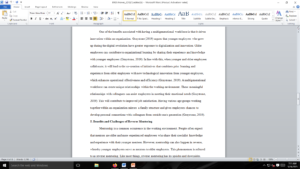Multigenerational workforce
Each case study analysis must adhere to the following criteria:
- Submitted as a Word document
- Approx. 800-1000 words, (2 pages max), 1.5 spacing, 1” margins, 12pt Times New Roman font.
- Grammar and professionalism are required including full sentences
- APA style referencing
- Include sections for problem statement, Alternatives, and Solution
- SWOT analysis can be used but not necessary
- All information you are to make decisions on must be in the case study. While you are able to bring knowledge such as different tactics and calculations you are not to bring in other “real world” solutions, unless instructed to.
E.g. if you are given a real world company and asked which direction they should take, the direction should be based off information only given in the case and not what the company did in the real world.
| Task | Tool | Weighting | Due Date |
| Picture and biography posted to Canvas | Rubric A | 10% | 08-29-22 |
| Participation in class discussion board | Rubric B | 20% | Continuous |
| Analysis on Case Studies 5% x 6 | Rubric C | 30% | 09-12-22
09-19-22 10-03-22 10-10-22 10-24-22 10-31-22 |
| Individual Assignment: How have international food and beverage trends influenced a recovering competitive industry | Rubric D | 40% | 11-28-22 |
| Total | 100% |
Requirements: Approx. 800-1000 words, (2 pages max), 1.5 spacing, 1” margins, 12pt Times New Roman font. | .doc file
Answer preview
Learning how to effectively manage a cross-generational workforce is vital. Failure to do so can have adverse consequences for a manager or leader (Rajput et al., 2019). In Gladys’s case, her poor management approach to her Gen Y peers led to unhappiness to the extent that Jorge was on the verge of quitting (Mejia & Lavendol, 2015). As a millennial, Gladys needs to improve how she manages employees from multiple generations, including her Gen Y peers, Jorge and Esmeralda. One of the solutions that can help Gladys overcome her cross-generational management problems is embracing open communication (Rajput et al., 2019). Good and open communication with employees from different generations will allow Gladys to understand employees’ preferred ways of working (Rajput et al., 2019). For instance, communicating openly with Jorge and Esmeralda would have allowed Gladys to discover that Jorge preferred autonomy when working, and Esmeralda liked to be involved in operations. Alternatively, Gladys can
[1196 Words]

Multigenerational workforce

